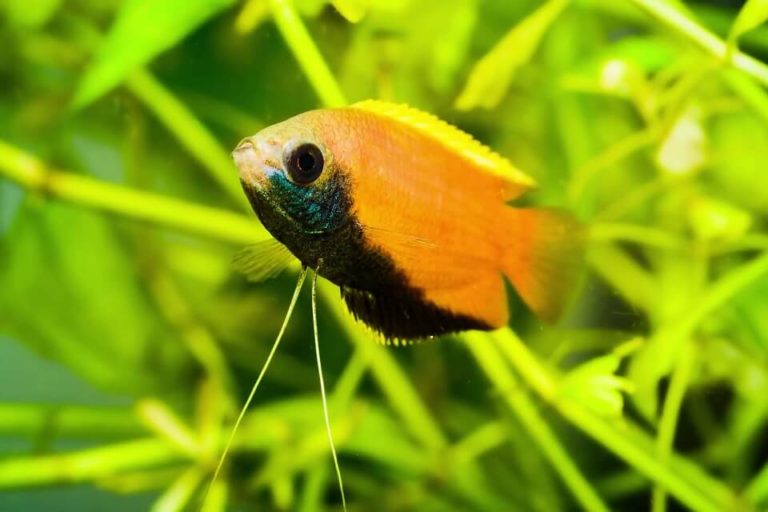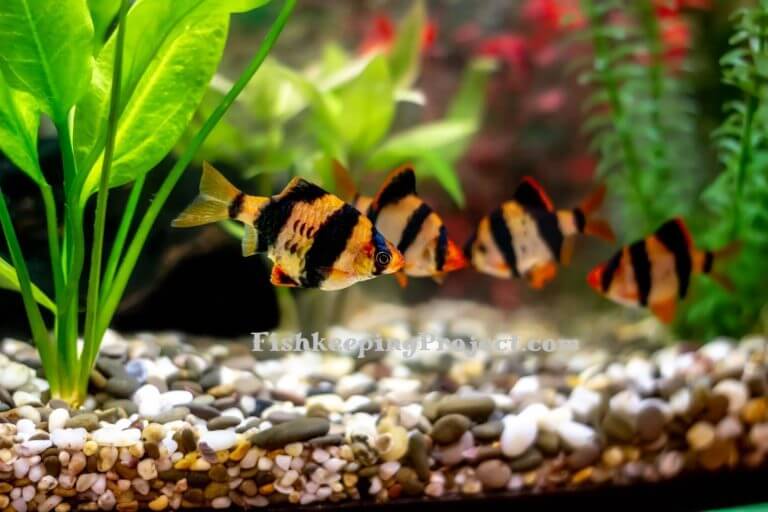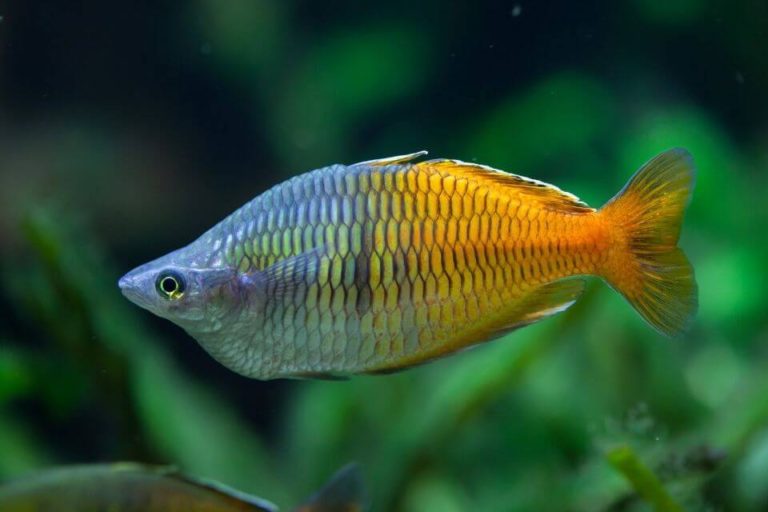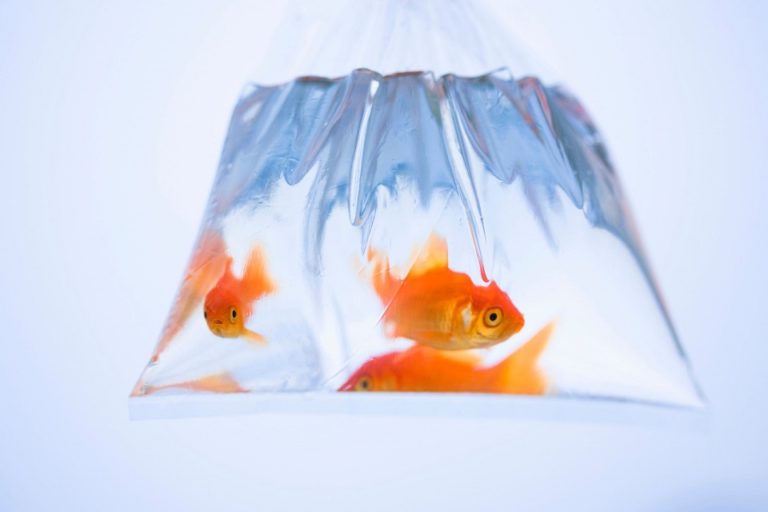Emerald Dwarf Rasbora Care: Size, Lifespan, Food, Tank Mates, Tank Size

Emerald Dwarf Rasbora beats the excitement of new fish species in a freshwater aquarium tank. However, the species you choose will determine the success or failure of your aquarium journey.
Unfortunately, you may make the wrong choice of fish species and lose them; this should not kill your spirit for fish keeping. It would be best if you were excited because you can never learn without making mistakes.
Fishkeeping is easy; however, it depends on the species of fish you are rearing. Some species are easy to care for; others are difficult to rear.
As a beginner, you need to start with fish species that are easy to rear because they require less caring. As you slowly graduate from a beginner to an experienced fish keeper, you can start rearing the difficult ones in your aquarium.
However, they are not difficult to rear; you need to be experienced in fish keeping because one wrong decision will lead to all the fish dying in the aquarium.
This article will provide you with detailed information on Emerald Dwarf Rasbora care and species profile. Let’s get started!
| Quick Facts: | |
|---|---|
| Common Names | Emerald Dwarf Rasbora, Emerald Dwarf Danio |
| Origin | Inle Lake in Myanmar, South East Asia |
| Family | Cyprinidae |
| Scientific Name | Danio erythromicron (syn. Microrasbora erythromicron) |
| Care Level | Easy |
| Temperament | Very peaceful |
| Social | Community fish |
| Diet | Omnivores |
| Size (average) | 1 - 1.5 inches |
| Lifespan | 3 - 5 years |
| Breeding | Egg layer |
| Minimum Tank Size | 10 gallons (approximately 35 liters) |
| Tank Setup | Freshwater, Gravel or Sand substrate, Driftwood, and Rocks for decorations, A lot of live plants |
| Tank Temperature | 70 - 77 °F (21 – 24 °C) |
| Water Hardness | 4 - 12 dGH |
| Water pH Level | 6.5 - 7.5 |
Species Overview
If you want your aquarium to be full of life and color, it would be best to choose Emerald Dwarf Rasbora. Their scientific name is Danio erythromicron (syn. Celestichthys erythromycin) and is small fish with big personalities.
It is also commonly known as Emerald Dwarf Danio in the aquarium trade. Moreover, these fish are highly curious and active in a decorated aquarium. You will see them sparing or playing with others.
The Emerald Dwarf Rasbora species are shoals, meaning they live in groups. However, the males will spar with each other.
Moreover, they produce so much waste; therefore, it is important to ensure that your aquarium tank can handle the volume of waste to ensure that all the nitrates and ammonia are filtered out.
Emerald Dwarf Rasbora Size
The average Emerald Dwarf Rasbora size is 1 to 1.5 inches long. These fish are tiny and will do well in nano tanks also. They will be a half-inch in size when you buy them.
Although they have a fast growth rate and do not take time to reach Emerald Dwarf Rasbora size at maximum length. Moreover, the largest fish in this species grows up to 2 inches under optimal care. The females are large than the males.
Emerald Dwarf Rasbora Lifespan
The Emerald Dwarf Rasbora lifespan is 3 to 5 years. It is a reasonable life span for such small fish. Because these fish are tiny, you need to provide them with pristine living conditions to be healthy.
Without proper care, they will be prone to diseases and die before the expected Emerald Dwarf Rasbora lifespan.
Appearance and coloration
These tiny fish have beautiful details that are eye-catching. They have slender and long bodies and large shimmering eyes. Also, they have semi-transparent scales on their gill plate.
Moreover, their body is orange or coral pink and has a beautiful appearance against a plant-covered backdrop or in the darkness that will smite you.
The base is composed of stripes with emerald green, which shimmers create a unique display when the fish is swimming around the tank. The stripes have various colors; some appear blue and others are purple.

The base of the tail has a dot on each side of the body. The dot is a type of mimicry looking like an eye that tricks a predator in the wild. The males are more colorful than the females.
The male fins are orange or red, while the females have transparent fins.
Behavior and temperament
These fish have a unique temperament; they are the schooling type and feel comfortable in a group of their species. Moreover, these fish are a great choice for your community aquarium.
These tiny fish are peaceful by nature; however, they easily get stressed because they are sensitive. Make sure you provide them with healthy living conditions for them to thrive. Moreover, these species like hiding a lot.
Thus, they can be good aqua pets and you can engage them and play hide and seek with them during your leisure time.
Emerald Dwarf Rasbora Care
Caring for Emerald Dwarf Rasbora is easy so long as you maintain quality water to sustain the health of this tiny fish. These fish species need a consistent water supply in the tank.
You have to clean the tank properly and do 25 % to 50% water changes twice a month. If you have dense vegetation in the tank, you need to change 25% of the water every week.
Also, it would be best if you kept the tank tidy and clean. Moreover, every time you vacuum the substrate, do a water change. The Emerald Dwarf Rasbora are less susceptible to fish diseases.
However, they are sensitive to their living environment, which explains why they are easily stressed. When stressed, they are likely to get sick.
These fish is sensitive to medication; thus, if you want to add medicines to the tank, do it slowly to avoid poisoning the fish. Moreover, if you add tank mates, aquarium décors, or substrate, make sure the tank is well-cleaned.
You need to ensure that the tank has adequate space for these tiny fish to have hiding areas and room for playing; they will thrive and live longer.
– Emerald Dwarf Rasbora Tank Size
These fish species are tiny, so they do not need a big space to be happy. It would be best if you kept them in a 10 gallons tank. It is the least Emerald Dwarf Rasbora tank size you can use to keep them.
However, the recommended Emerald Dwarf Rasbora tank size is 20 to 25 gallons tank for them to have stress free environment. When you have a spacious tank you will be able to keep a school of 25 to 30 fish.
– Emerald Dwarf Rasbora Tank Setup
To have the best tank set up for Emerald Dwarf Rasbora, you must ensure all the essentials needed in the tank are present. Follow this quick guide for the best tank setup
- Pick a tank with a capacity of 20 gallons. The bigger the tank, the better; they will have more space to swim around. The size of the tank will determine the number of fish you will keep. Despite the size, you pick, ensure it has enough space for this species to swim around and hide.
- It would be best to use a dark-color substrate at the bottom of the tank; it will mimic the loam substrate and make their color glitter. Also, you should use fine sand for safety and avoid gravel if possible.
- Ensure the tank has subdued lighting. Too much bright light is not conducive for the fish.
- Keep the temperatures of your tank between 70 degrees to 77 degrees Fahrenheit.
- Ensure that the water of the tank is slightly alkaline, and try as much as possible to maintain a pH of 6.5 to 7.5.
- Ensure the filtration system is working throughout; these fish species stay in large groups, resulting in too much waste. Your filtration system should have a water flow of four to five times the tank’s volume. By doing this, the tank will be efficiently cycled, removing any nitrates and ammonia.
- These fish are fond of soft water parameters. You should maintain water hardness in their tanks at 4 to 12 dGH.
- It would be best if you chose plants to put in your tank so that the fish can have places to hide. It would be best to use floating and leafy plants; you can use driftwood, although you should avoid natural driftwood and leaf debris because they can release tannins.
- Tannins will stain the water and these fish will not be able to tolerate such water for long. Also, you can add rocks, and roots and make small, simple caves using branches. With such, these fish will have much playing and hiding.
- You can add dry leaves to the tank, they will grow microbe and the Emerald Dwarf Rasbora will use them as a secondary food source.
– Water Parameter And Testing
The natural habitat of the Emerald Dwarf Rasboras is unique. The water is crystal clear, but lake Inle is in a valley of nine hundred meters above sea level.
Because of this kind of environment, these fish prefer neutral pH and temperatures. Therefore their water tank pH should be slightly alkaline.
If you stick to the following parameters, your fish will thrive and live for long
- Water temperature: 70 – 77 degrees Fahrenheit (21 – 24 °C)
- Hardness of water: 4 – 12 dGH
- Water acidity levels: 6.5 – 7.5 pH
You should ensure that you buy a reliable and accurate tank water test kit to keep track and ensure the parameters are in check.
Suitable aquarium plants
Plants will provide hiding places for these fish species. The plants are also important; they will help remove carbon iv oxide stocked in the tank.
Moreover, plants will absorb nitrites, nitrates, and ammonia waste from fish, which become harmful to the fish when left to build up. Plants help control unwanted algae’s growth by out-competing with it for space and food in the tank.
Examples of suitable aquarium plants include;
Common diseases and prevention
Emerald Dwarf suffers from all freshwater fish diseases. The disease includes swim bladder, parasitic infections, and ich.
Ich is very common and is caused by poor water conditions, where the fish will have white itchy spots on the body. If the ich is not treated, the fish will die.
Moreover, if this disease is left untreated, it will spread rapidly in the tank because it is highly contagious. So ensure that your tank has the right water conditions and test the water to maintain consistency.
Swim bladder disease is a very dangerous disease. The bacteria destroys the swim bladder of the fish, therefore, affecting the buoyancy and swimming ability of the fish. Eventually, the fish dies if left untreated.
Poor water conditions contribute greatly to this infection of the bladder. Make sure your tank has a quality filtration system and you change the water at least once a month.
Skin flukes are parasitic infections that latch on the gills or skin. The infection leads to difficulty breathing. Moreover, a fish that has this disease should be treated immediately as the fish has a low chance of survival with this type of disease.
Prevention
The best way to prevent these diseases is to ensure that the water parameters are met and maintained. Without this, your fish will suffer from diseases and eventually die.
The diseases mentioned above are dangerous; however, they can be treated with over-the-counter drugs and you can quarantine your fish. If you medicate and quarantine your fish, they will be healthy again in no time.
Emerald Dwarf Rasbora Diet and feeding
It is easy to feed Emerald Dwarf Rasbora; they eat any fish food, plus they are omnivores. In the wild, they eat plankton, bloodworms, and insect. However, when in an aquarium, they need a varied diet.
Suppose you want to maintain proper dieting and feeding for their health. You can feed the fish tablet food or flake food containing natural pigments. Also, you can feed them nutritious fish food such as carotenoids, algae, and spirulina.
You can also feed them live fish food to ensure it is small to fit in their mouths. Also give them brine shrimp or daphnia, which is easy for them to eat.
You should ensure their diet has enough meat food to consume enough protein for their living. The best way to feed your Emerald Dwarf Rasbora is to give them small amounts of food many times a day then feed them at once with too much food.
These fish species only eat for five minutes; therefore, ensure you provide them with the amount of food they can eat for that time. The excess food will decompose in the tank and make the water unhealthy and impure.
Gender differences
The female has a rounded belly and is larger than the male. The males show intense coloration during breeding.
Emerald Dwarf Rasbora Breeding
Emerald Dwarf Rasboras frequently breed with less intervention and are eager spawners. However, to have a successful spawning, you need to put proper assortments in the breeding tank with dense plantation.
The Emerald Dwarf Rasboras are egg scatterers. If you want to control spawning then keep three pairs of the fish in a conditioned tank where there is live fish food every time for about two weeks.
Also, conditioning the fish during breeding will make the male acquire a bright color and well-fed females will produce quality eggs. When setting up the breeding tank, your fish need to have a dim environment.
To make suitable breeding conditions, you need to have soft water of two to three dGH hardness levels in the tank. Also, the water in the tank needs to be alkaline and you should enhance the water temperature slightly.
To ensure the water of your nurture tank is clean, add a sponge filter. Also, you can do peat filtration. Moreover, you need to add vegetation to the tank; you can incorporate Cabomba or milfoil.
You will add a spawning mop or marbles on the substrate to save eggs that fall off the aquarium plant. The adult fish will take one to two weeks to get used to the new tank conditions.
These fish will spawn during morning hours in the tank and deposit fifty eggs on the plant. After eggs are laid, you will remove the parent fish from the tank because they like to eat away fries.
Fries start appearing after twenty-four to thirty-six hours of spawning. The fries will survive on the yolk sac for twenty-four hours and then after that, they will start doing free swimming.
You can feed them fish fry foods such as liquid fry fish or infusoria foods. As these fries grow larger, you can start offering them hatched brine shrimp or flake food.
Emerald Dwarf Rasbora Tank Mates
The Emerald Dwarf Rasbora can thrive in a community tank; however, they are naturally con-specific. Hence, keeping these fish at least in groups of 8 members in a community tank is important to make them comfortable.
Choosing Emerald Dwarf Rasbora tank mates would be a bit challenging and they hide and tense easily when kept with other large fish.
The tank mate you choose for your Emerald Dwarf Rasbora needs to have the same size. It would be best to house them with tropical fish; they are peaceful and not active.
Also, it would be best if you did not house them with large-aggressive, aggressive, or semi-aggressive fish. Moreover, they reside peacefully with snail, crab, or shrimp.
Examples of suitable Emerald Dwarf Rasbora tank mates you can choose include;
- Otocinclus Catfish
- Pygmy Corydoras
- Cherry Barb
- Celestial Pearl Danio (Galaxy Rasbora)
- Ramshorn Snail
- Silver Tip Tetra
- Glowlight Tetra
- Chili Rasbora
- Clown Killifish
- Guppies
- Green Neon Tetra
Origin and distribution
The origin of Emerald Dwarf in Myanmar, South East Asia, and it is a popular species in aquariums. You can find these fish on the Malay Peninsula in southern Thailand or South East Asia.
Also, you can find them in Singapore and Eastern Sumatra. These fish are found in abundance on the island of Riau and Bintan in Indonesia. Furthermore, some species are found in Lake Inle found in South-Eastern Asia.
These fish are like inhabiting the rivers that connect to peat swamps, dark water streams, and slow-flowing water. Also, you can find these fish in ditches and ponds. Additionally, these small fish are fond of hiding in the branches or fallen leaf litter.
FAQs
Are Emerald Rasboras Aggressive?
No, these fish are not aggressive. They are peaceful fish and live in harmony and unity with other tank mates. However, you need to be worried about them becoming food for others.
Is Emerald Rasboras Shy?
Yes, they are shy. When you approach the tank, you will see the fish running into hiding in the rocks and plants.
3. How Many Emerald Rasbora Can You Keep?
For a minimum tank size of 10 gallons, you can house 6 Emerald Dwarf Rasboras. But if you have a bigger tank, you can house more so long as you leave space for them to play.
4. Are Emerald Dwarf Rasboras Fin Nippers?
No, they are not. However, you may see some aggression when the males compete, but it never results in a serious injury.
5. How Big Do Dwarf Emerald Rasboras Get?
Their full maturity size is 1 to 1.5 inches in size in a captivity environment. However, these fish grow up to 2 inches in size in the wild.
6. How Many Emerald Dwarf Rasboras Are In A Gallon?
If a 10 gallons tank can house a group of six, then a gallon will probably house a group of 2 to 3 fish.
7. Can Emerald Rasboras Live With Bettas?
Yes, they can live with bettas. They make great tank mates; both enjoy the same conditions and are peaceful.
8. How Much Does An Emerald Dwarf Rasbora Cost?
The cost of Emerald Dwarf Rasbora varies greatly in different stores and they are difficult to find. The average cost of a 5 pack of fish is $25 on eBay.com.
Final thoughts
Emerald Dwarf Rasbora is an excellent choice of freshwater fish for keeping in your aquarium. They are sensitive to the water tank and a change in the water can wipe them out.
Also, you must choose good tank mates for them because they get stressed quickly. Thanks for reading through this Emerald Dwarf Rasbora care article. Feel free to use this article as a guide in keeping for Emerald Dwarf Rasbora care.







